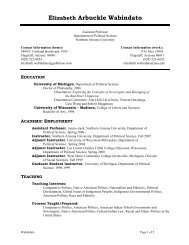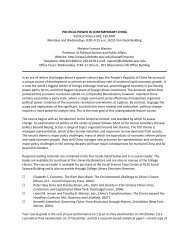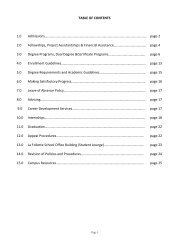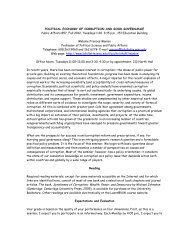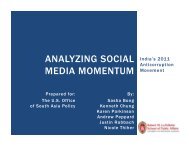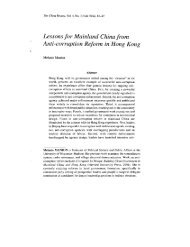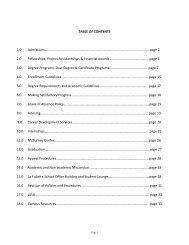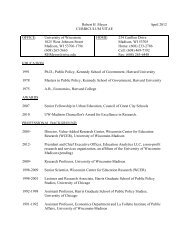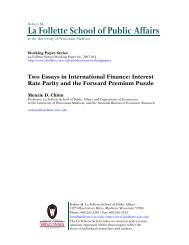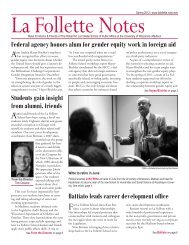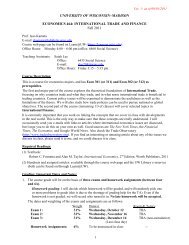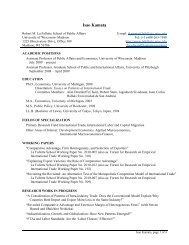SAVE Commission's findings - La Follette School of Public Affairs ...
SAVE Commission's findings - La Follette School of Public Affairs ...
SAVE Commission's findings - La Follette School of Public Affairs ...
You also want an ePaper? Increase the reach of your titles
YUMPU automatically turns print PDFs into web optimized ePapers that Google loves.
3.3<br />
personal responsibility focus, through a dialogue<br />
<strong>of</strong> a Citizens Bill <strong>of</strong> Responsibilities, as<br />
suggested in the Preamble.<br />
Tap Wisconsin knowledge to develop science<br />
and technology policy. To address public policy<br />
questions presented by scientific discovery and<br />
application, a consortium <strong>of</strong> public and private<br />
higher educational institutions should join<br />
with business to assist government in answering<br />
21st Century questions.<br />
GOAL #4: TAKING RESPONSIBILITY<br />
4.1<br />
Find new paths to the self-reliant community.<br />
It is not government’s role to provide for all.<br />
Therefore, initiate a serious dialogue about how<br />
to design a new social sector involving the<br />
public sector, business, not-for-pr<strong>of</strong>its and citizens<br />
to which all contribute and from which<br />
all benefit.<br />
4.2<br />
See the entire community as able to serve. To<br />
fully tap everyone’s capacity to meet individual<br />
or community needs, identify and remove the<br />
inappropriate barriers that prevent not-forpr<strong>of</strong>its,<br />
businesses and others from serving the<br />
community good. Ensure a level playing field<br />
and fair competition for both public and private<br />
providers by evaluating total cost to provide<br />
service.<br />
4.3<br />
Government programs and employees become<br />
helpers. To help people do things for<br />
themselves, government programs and program<br />
workers should be guided by the vision<br />
<strong>of</strong> helping citizens become self-sufficient and<br />
helping communities reach social goals<br />
through cooperation and partnerships.<br />
4.4<br />
Return public health to the public agenda. To<br />
cope with serious 21st Century threats to public<br />
health, develop a state-led strategy that revives<br />
and reorganizes—through new partnerships—an<br />
approach to public health that is<br />
driven by preventive measures and personal<br />
responsibility.<br />
CHAPTER 2: A 21ST CENTURY COMMUNITY THAT<br />
WORKS<br />
GOAL #5: COOPERATING COMMUNITIES<br />
5.1<br />
Create tension and incentives to encourage<br />
intergovernmental cooperation. To encourage<br />
5.2<br />
5.3<br />
5.4<br />
5.5<br />
intergovernmental and interagency cooperation,<br />
withhold as much as 5 percent <strong>of</strong> all<br />
1995-97 funding sources, except federal funds.<br />
Reallocate a portion <strong>of</strong> withheld funds back to<br />
the governmental unit when documentation<br />
<strong>of</strong> measureable results <strong>of</strong> cost savings, efficiencies<br />
and cooperation are provided.<br />
Identify an intergovernmental efficiency broker<br />
function. To save money and improve service,<br />
assign a high level intergovernmental efficiency<br />
broker function in the Dept. <strong>of</strong> Administration<br />
that would use data as a point <strong>of</strong><br />
dialogue. It would use tools, such as a certificate<br />
<strong>of</strong> convenience, to validate cooperation,<br />
do economic analyses, assess risk and promote<br />
innovation under federal delegation.<br />
Pay once for local government service. To<br />
achieve tax fairness and encourage broad cooperation,<br />
require that local taxpayers pay once<br />
for service. This benefits communities that pay<br />
for their own police, health and other services<br />
provided by the county. It would cost communities<br />
that use county services without paying<br />
for them. This recognizes that some services<br />
benefit all, even though they are not provided<br />
directly.<br />
Focus multiple programs on rebuilding communities.<br />
To make best use <strong>of</strong> the broadest<br />
range <strong>of</strong> community development ingredients,<br />
adopt a results-driven clearinghouse approach.<br />
Include: Community Learning Centers (see<br />
Goal #11); Main Street Program; state facility<br />
placement in central cities and regions; opportunities<br />
for state employees to work out <strong>of</strong><br />
homes or cars; urban forestry; recreational aids;<br />
infrastructure investment; housing and small<br />
business help; public safety; community education;<br />
and urban university service (see Goal<br />
#13).<br />
Review the fit between local government and<br />
new century needs. To bring local government<br />
into the modern age, by 1998, call a local government<br />
statutory revision convention to:<br />
evaluate the number and size <strong>of</strong> governments,<br />
school districts, technical college boards and<br />
CESAs; evaluate incentives to merge; judge the<br />
size <strong>of</strong> boards and councils; appoint, not elect,<br />
pr<strong>of</strong>essional <strong>of</strong>fices such as treasurer, sheriff<br />
and surveyor; and address barriers to public<br />
service. Ask, “Would we design it this way if<br />
we did it again?” (see Goal #10).<br />
CITIZEN • COMMUNITY • GOVERNMENT — WISCONSIN: THE 21 ST CENTURY 61



